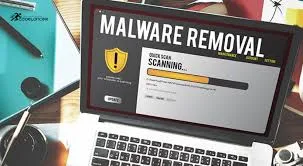परिचय:
कंप्यूटर वायरस हटाने के लिए कदम:
1. संक्रमण की पहचान करें:
- लक्षण: धीमा प्रदर्शन, बार-बार क्रैश, असामान्य पॉप-अप और सेटिंग्स में अनधिकृत परिवर्तन वायरस संक्रमण का संकेत दे सकते हैं।
- एंटीवायरस स्कैन: सिस्टम को वायरस के लिए स्कैन करने के लिए एक प्रतिष्ठित एंटीवायरस या एंटी-मैलवेयर प्रोग्राम का उपयोग करें।
2. इंटरनेट से डिस्कनेक्ट करें:
- कंप्यूटर को इंटरनेट से डिस्कनेक्ट करने से वायरस को अन्य उपकरणों में फैलने से रोका जा सकता है और इसे इसके स्रोत से संवाद करने से रोका जा सकता है।
3. सुरक्षित मोड में प्रवेश करें:
- कंप्यूटर को पुनरारंभ करें और सुरक्षित मोड में प्रवेश करें। सुरक्षित मोड केवल आवश्यक प्रोग्राम चलाता है, जिससे वायरस को हटाना आसान हो जाता है।
4. अस्थायी फ़ाइलें हटाएं:
- अस्थायी फ़ाइलों को हटाने के लिए डिस्क क्लीनअप या समान टूल का उपयोग करें। यह कुछ वायरसों को हटाने और एंटीवायरस स्कैन के लिए जगह खाली करने में मदद कर सकता है।
5. पूरी प्रणाली स्कैन चलाएं:
- वायरस का पता लगाने और उसे हटाने के लिए एक विश्वसनीय एंटीवायरस प्रोग्राम के साथ एक पूर्ण स्कैन करें। संक्रमित फ़ाइलों को संगरोध या हटाने के लिए एंटीवायरस सॉफ़्टवेयर के निर्देशों का पालन करें।
6. सॉफ़्टवेयर और ऑपरेटिंग सिस्टम अपडेट करें:
- सुनिश्चित करें कि सभी सॉफ़्टवेयर और ऑपरेटिंग सिस्टम को नवीनतम संस्करणों में अपडेट किया गया है। अपडेट अक्सर नए खतरों के खिलाफ सुरक्षा पैच शामिल करते हैं।
7. सभी पासवर्ड बदलें:
- अनधिकृत पहुंच को रोकने के लिए सभी खातों के पासवर्ड बदलें, विशेषकर यदि संवेदनशील जानकारी से समझौता किया गया था।
8. बैकअप से फ़ाइलें पुनर्स्थापित करें:
- यदि महत्वपूर्ण फ़ाइलें भ्रष्ट हो गई हैं, तो उन्हें बैकअप से पुनर्स्थापित करें यदि उपलब्ध हो। सुनिश्चित करें कि बैकअप साफ और वायरस-मुक्त है।
9. फ़ायरवॉल और सुरक्षा सुविधाएँ सक्षम करें:
- अतिरिक्त सुरक्षा प्रदान करने के लिए सुनिश्चित करें कि फ़ायरवॉल और अन्य सुरक्षा सुविधाएँ सक्षम हैं।
10. पेशेवर मदद लें:
- यदि वायरस लगातार बना रहता है या गंभीर समस्याएं पैदा कर रहा है, तो पेशेवर तकनीशियन या आईटी समर्थन सेवा से मदद लें।
रोकथाम के टिप्स:
- एंटीवायरस सॉफ़्टवेयर इंस्टॉल करें: विश्वसनीय एंटीवायरस सॉफ़्टवेयर का उपयोग करें और इसे अपडेट रखें।
- संदिग्ध लिंक और डाउनलोड से बचें: अज्ञात लिंक पर क्लिक न करें या अविश्वसनीय स्रोतों से फ़ाइलें डाउनलोड न करें।
- नियमित बैकअप: महत्वपूर्ण फ़ाइलों का नियमित रूप से बाहरी ड्राइव या क्लाउड स्टोरेज में बैकअप लें।
- सूचित रहें: नवीनतम सुरक्षा समाचार और वायरस अलर्ट के बारे में अपडेट रहें।
Introduction:
A computer virus is a malicious software program designed to
infect and potentially damage computers and networks. Viruses can corrupt
files, steal sensitive data, and cause significant performance issues. Removing
a computer virus involves several steps to ensure complete eradication and the
protection of the system from future infections.
Steps for Computer Virus Removal:
1. Identify the Infection:
- Symptoms: Slow
performance, frequent crashes, unusual pop-ups, and unauthorized changes in
settings can indicate a virus infection.
- Antivirus Scan:
Use a reputable antivirus or anti-malware program to scan the system for
viruses.
2. Disconnect from the Internet:
- Disconnecting the
computer from the internet prevents the virus from spreading to other devices
and stops it from communicating with its source.
3. Enter Safe Mode:
- Restart the
computer and enter Safe Mode. Safe Mode runs only essential programs, making it
easier to remove the virus.
4. Delete Temporary Files:
- Use Disk Cleanup
or a similar tool to delete temporary files. This can help remove some viruses
and free up space for the antivirus scan.
5. Run a Full System Scan:
- Perform a thorough
scan with a reliable antivirus program to detect and remove the virus. Follow
the antivirus software's instructions to quarantine or delete infected files.
6. Update Software and Operating System:
- Ensure all
software and the operating system are updated to the latest versions. Updates
often include security patches that protect against new threats.
7. Change All Passwords:
- Change passwords
for all accounts to prevent unauthorized access, especially if sensitive
information was compromised.
8. Restore Files from Backup:
- If important files
were corrupted, restore them from a backup if available. Ensure the backup is
clean and virus-free.
9. Enable Firewalls and Security Features:
- Ensure that
firewalls and other security features are enabled to provide an additional
layer of protection.
10. Seek Professional Help:
- If the virus is
persistent or causing severe issues, seek help from a professional technician
or IT support service.
Prevention Tips:
- Install Antivirus Software: Use reliable antivirus software
and keep it updated.
- Avoid Suspicious Links and Downloads: Do not click on
unknown links or download files from untrusted sources.
- Regular Backups: Regularly back up important files to an
external drive or cloud storage.
- Stay Informed: Keep up-to-date with the latest security
news and virus alerts.





No comments:
Post a Comment